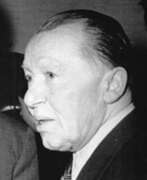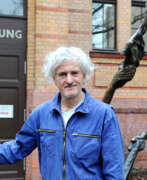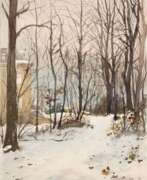German Democratic Republic


Hans Brass was a German artist of the first half of the twentieth century. He is known as a painter and graphic artist, famous for his expressionist works.
Hans Brass created landscapes in a traditional style at the beginning of his career. However, between 1917 and 1923 he turned to Expressionism, Cubism and Futurism. From 1921 he became interested in abstract art, and until 1933 he created abstract works and works with religious content. By 1948 Brass had developed his own unique style based on his expressionist experience. From 1952 he worked in watercolor, depicting landscapes and flowers.


Conrad Felixmüller was a twentieth-century German artist, born Conrad Felix Müller. He is known as a painter, graphic artist, illustrator and printmaker, a representative of the New Materiality movement, who worked in the Expressionist style.
Felixmüller created about 2,500 paintings and graphic drawings, the main motif of which was the human being. The artist considered himself a socially critical expressionist, and his works reflected scenes from everyday life. In the 1930s, many of his works were confiscated by the Nazis as examples of degenerate art and destroyed. As a result of the bombing of Berlin in 1944, Felixmüller lost much of his work.


Otto Griebel was a German artist of the twentieth century. He is known as a painter and graphic artist who worked in the directions of "new subject matter" and socialist realism.
Griebel joined the Dadaists after World War I and was a member of the Dresden Dadaist group. He participated in various artistic associations, including the Dresden Secession Group, the Aktion group of artists, the Association of Free Artists of Saxony, and others. In 1933, the artist was arrested by the Gestapo and his work was recognized as "degenerate art". Most of the master's work was lost during the bombing of Dresden in 1945.
Griebel was also a talented puppet theater artist and created sets for puppet shows.


Lea Grundig was a German twentieth-century artist of Jewish descent. She is known as a graphic artist, illustrator, teacher, and professor at the World School of Fine Arts in Dresden.
Grundig addressed political and social themes in her graphic series created in Germany, including works devoted to exposing the Nazi regime. In 1936, the artist was arrested by the Nazis and her work was declared "degenerate art."
Grundig was president of the GDR Artists' Union. In 1972, she organized the Hans and Lea Grundig Foundation to support the cultural, pedagogical and artistic achievements of students and graduates of the Kaspar-David Friedrich Institute at the University of Greifswald.


Hans Grundig was a German artist of the first half of the twentieth century. He is known as a painter, graphic artist and teacher, professor and rector of the High School of Fine Arts in Dresden, and husband of the artist Lea Grundig.
Grundig produced works that stylistically belong to the "new materiality" and revolutionary-proletarian realism. In 1932 he visited the USSR, where he participated in the exhibition "Revolutionary Art in Capitalist Countries" in Moscow. His art during this period was strongly anti-fascist, the works were created in a realistic-expressive style. After the Nazis came to power, he was banned from painting and his works were recognized as "degenerate art". The artist was arrested and sent to the Sachsenhausen concentration camp.
Grundig's paintings today are an important part of the golden fund of realist art in twentieth-century Germany.




Sergey Yakovlevich Lagutin (Russian: Сергей Яковлевич Лагутин) was a Soviet and Russian artist of the second half of the twentieth and early twenty-first centuries. He is known as a painter, scenographer, teacher and art theorist.
Sergey Lagutin began his career in 1934 while serving in the army, where he first participated in an exhibition of military artists. Throughout his career, the artist designed theatrical performances and worked in theaters in East Germany and the USSR. His contributions to the field of art include the development of the program and methodology for teaching composition adopted in all art schools in Russia.


Max Lingner was a German artist of the first half of the twentieth century. He is known as a painter, graphic artist, muralist and teacher.
Max Lingner at the beginning of his career, studying in Paris, was influenced by Impressionism. He worked as a painter and engraver for the newspaper Le Monde. Joining the French Communist Party, Lingner fought on the Republican side during the Spanish Civil War and fought against the Nazis in the Resistance Movement in France. After returning to the GDR, he became a professor and created the monumental panel "Building the Republic" in the House of Ministers. The artist donated the 40 paintings, prints and watercolors he had brought back to the state.


Jeanne Mammen was a twentieth-century German artist. She is known as a graphic artist and draftsman, a representative of modernism, a prominent figure in the artistic life of the Weimar Republic.
Jeanne Mammen developed an artistic style close to the New Materialism school. As she grew older, her work became more symbolic; after 1945, the artist moved towards abstractionism. She worked for fashion magazines, created movie posters, and illustrated erotic poetry. Mammen actively developed collage techniques, as well as creating portraits and caricatures, and sketching street types.


Otto Nagel was a German artist of the first third of the twentieth century. He is known as a painter and graphic artist, one of the most famous artists of the GDR.
Otto Nagel's work focused on depicting Berlin through portraits, life scenes and cityscapes. He was an important figure in the German art scene. In 1933 he was elected chairman of the All-German Artists' Association, but this association was soon dissolved by the Nazis who came to power.
Nagel was president of the GDR Academy of Art. His name is immortalized in the names of streets and institutions in Germany.


Oskar Nerlinger, born on March 23, 1893, in Straubenhardt, Germany, was a notable German painter whose career spanned the early to mid-20th century. His work was part of the painting event in the art competition at the 1932 Summer Olympics, highlighting his recognition in both the art and sports communities. He also worked under the pseudonym Nilgreen.
Nerlinger's art primarily focused on painting, and he became known for his unique style and contributions to the art world during a time of significant cultural and political change in Germany. His artworks reflected the trends and movements of his era, capturing the essence of the period in which he lived and worked.
While specific details about Nerlinger's most famous works or their presence in museums and galleries are not readily available, his participation in the 1932 Summer Olympics art competition suggests that his work received considerable recognition. This would be of particular interest to collectors, auctioneers, and experts in art and antiques, especially those with a focus on early 20th-century German art.
For those interested in exploring more about Oskar Nerlinger's life, work, and impact on the art world, further research and exploration into art history sources and museum collections that feature German art from this period would be beneficial.


Wolfgang Opitz is a contemporary German artist known for his abstract paintings.
Wolfgang Opitz studied art from 1964 to 1968 in Erfurt and Dresden. He met A. R. Penck, with whom he made many experimental films in 1969. They also founded the group Lücke in 1971, together with artists Harald Gallasch and Steffen Koonert (Turk). In 1989, Opitz fled East Germany to the West, where he received a teaching position at Lüneburg University in 1991.











































































